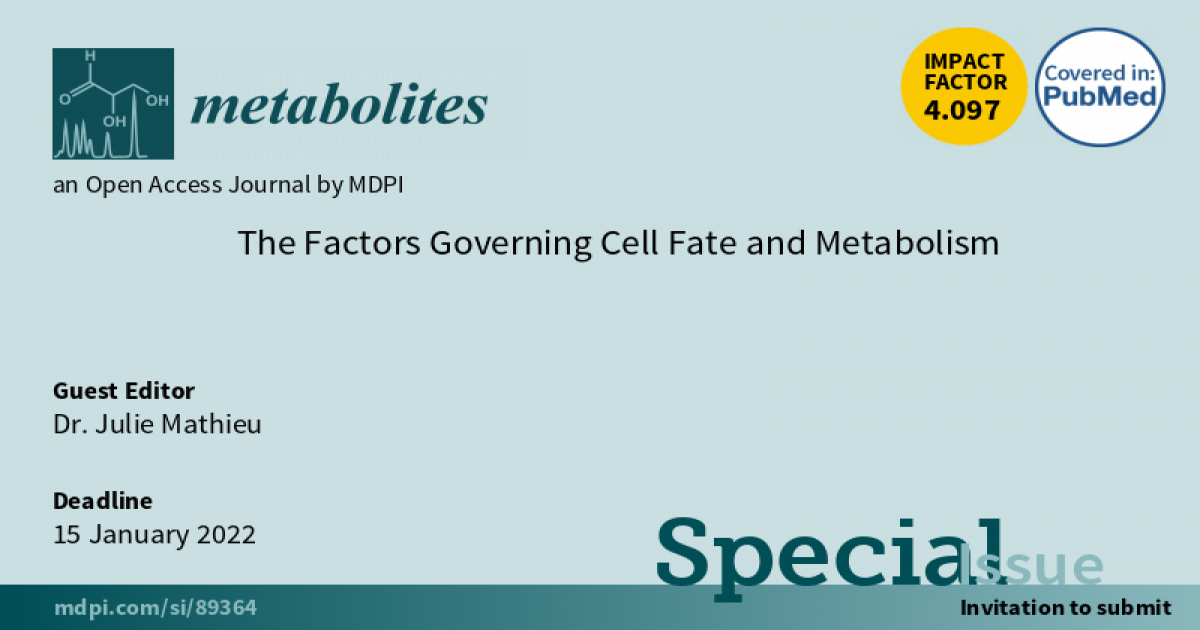- 3.7Impact Factor
- 6.9CiteScore
- 15 daysTime to First Decision
The Factors Governing Cell Fate and Metabolism
This special issue belongs to the section “Cell Metabolism“.
Special Issue Information
Dear Colleagues,
A fundamental goal of stem cell and developmental biology is to understand the mechanisms controlling cell fate decisions. Indeed, the development and regeneration of tissues rely on the proper fate commitment of stem cells. Cell fate is tightly regulated by a dynamic interplay between extrinsic and intrinsic factors. Every cell type has distinct metabolic demands related to their function and fate change is often accompanied by a metabolic switch. Recently, it has emerged that metabolism is not merely a consequence of cell fate changes, but is an important driver of cell fate decisions and lineage specification.
In this Special Issue, we welcome original research articles and reviews providing new insights into the factors that can control fate determination and in particular the role of metabolism and metabolites in cell fate decisions. This Special Issue will contribute to a better understanding of the role of metabolic changes in stem cell differentiation during normal organism development and in diseases.
Potential topics include but are not limited to the following:
- Metabolomics analysis and the influence of metabolites on cell fate.
- The involvement of organelles such as lysosomes and mitochondria in the metabolic regulation of cell fate.
- Cell signaling regulators of metabolic state and fate decisions.
- The impact of metabolism on cell fate in in vitro and in vivo models, including model organisms, rodents, and cells in 2D or 3D cultures.
- The actors governing metabolic switches in pluripotent stem cells stages (naïve/primed PSC) and adult stem cells, as well as during reprogramming, direct differentiation and trans-differentiation.
- The consequences of metabolic perturbations on cell fate in aging and in diseases such as obesity, degenerative disease, and cancer.
We are looking forward to your contribution to this Special Issue.
Dr. Julie Mathieu
Guest Editor
Manuscript Submission Information
Manuscripts should be submitted online at www.mdpi.com by registering and logging in to this website. Once you are registered, click here to go to the submission form. Manuscripts can be submitted until the deadline. All submissions that pass pre-check are peer-reviewed. Accepted papers will be published continuously in the journal (as soon as accepted) and will be listed together on the special issue website. Research articles, review articles as well as short communications are invited. For planned papers, a title and short abstract (about 250 words) can be sent to the Editorial Office for assessment.
Submitted manuscripts should not have been published previously, nor be under consideration for publication elsewhere (except conference proceedings papers). All manuscripts are thoroughly refereed through a single-blind peer-review process. A guide for authors and other relevant information for submission of manuscripts is available on the Instructions for Authors page. Metabolites is an international peer-reviewed open access monthly journal published by MDPI.
Please visit the Instructions for Authors page before submitting a manuscript. The Article Processing Charge (APC) for publication in this open access journal is 2700 CHF (Swiss Francs). Submitted papers should be well formatted and use good English. Authors may use MDPI's English editing service prior to publication or during author revisions.
Keywords
- Cell fate
- Metabolic reprogramming
- Stem cells
- Differentiation
- Metabolites
- Metabolomics
- Metabolic disruption

Benefits of Publishing in a Special Issue
- Ease of navigation: Grouping papers by topic helps scholars navigate broad scope journals more efficiently.
- Greater discoverability: Special Issues support the reach and impact of scientific research. Articles in Special Issues are more discoverable and cited more frequently.
- Expansion of research network: Special Issues facilitate connections among authors, fostering scientific collaborations.
- External promotion: Articles in Special Issues are often promoted through the journal's social media, increasing their visibility.
- e-Book format: Special Issues with more than 10 articles can be published as dedicated e-books, ensuring wide and rapid dissemination.

